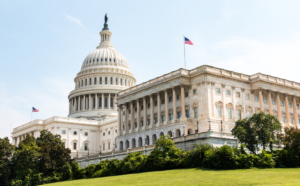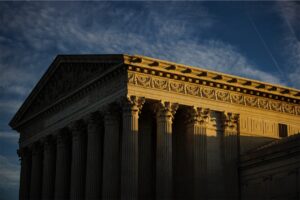It’s a limited government, after all

Not every problem has a solution, but that doesn’t seem to stop the government from attempting to supply one—even if the solution will make things worse. And even if the government doesn’t have the authority to solve a particular problem.
Recognizing the history of governments around the world to solve problems by controlling people’s lives, the drafters of our Constitution put strict limits on what the federal government could do. To further limit abuse, the Founders divided power among the three branches of government.
In our system of government, the federal government has only the powers expressly set out in the Constitution, and no more. The executive branch—which includes the president and all the federal agencies—can act only when Congress passes a law authorizing such actions. And it is up to the courts to make sure that Congress and the executive do not usurp the authority of the other, and that both act only within the bounds of constitutional authority.
The drafters of the Constitution were deliberate when they created the three separate branches, each with its own duties and responsibilities. They knew their history and were well aware of English civil wars and conflicts that occurred in the prior century when the King of England sought to assume all the powers of the parliament and the courts. James Madison wrote in Federalist No. 47: “The accumulation of all powers, legislative, executive, and judiciary, in the same hands, whether of one, a few, or many, and whether hereditary, self-appointed, or elective, may justly be pronounced the very definition of tyranny.”
He explained further, quoting Continental legal scholar Baron von Montesquieu, “‘There can be no liberty where the legislative and executive powers are united in the same person, or body of magistrates,’ or, ‘if the power of judging be not separated from the legislative and executive powers.’”
But today government bureaucracies sometimes wish to do much more than either Congress authorized or the Constitution permits. Wetlands are a perfect example.
The Constitution gives the federal government power to regulate commerce among the states. In the early days of the Republic, it was obvious to the courts that this included the power to regulate commerce on navigable waterways. A port in one state, for example, was not permitted to tax goods shipped from another state.
In time, that led to the understanding that no one could fill in a harbor or block a navigable river without the permission of the federal government through the Army Corps of Engineers. With the 1970s, there was a revival of environmentalist consciousness. Congress perceived a need to do more. And this is where things get tricky.
Congress gave both the Army Corps of Engineers and the then-new Environmental Protection Agency concurrent powers to “restore and maintain the chemical, physical integrity of the Nation’s Waters.” And for good measure, it threw in a section requiring that people get a permit from the Corps before depositing “dredged or fill material into the navigable waters.”
The word “wetland” is mentioned only once in the Act—and that only in the context of a governor’s authority to issue permits over activities adjacent to waters and adjacent wetland. And nowhere does the Act expressly extend authority to non-navigable tributaries of navigable waters.
Nevertheless, from this modest beginning, the EPA and Corps built a regulatory empire that claims the power to force people to obtain a federal permit before undertaking any activity on a wetland—even a wetland that is not adjacent to a navigable waterway and that lacks any meaningful connection to interstate commerce.
Now the Corps and the EPA might think it’s a really good idea to regulate every piece of damp ground in the nation. But just because something seems like a good idea, that doesn’t mean it’s a legal idea. When federal agencies interfere with people’s lives without legal authority or beyond the limits of the Constitution, it’s necessary for the courts to step in. Which the Supreme Court has done several times already and is about to do again.
The first big case came about after the federal government claimed authority to regulate wetlands and ponds that were totally isolated from navigable waters. Why? Because ducks travelling across state lines might land in such a pond, and because there was commerce in hunting ducks, that was enough for federal control over every isolated mud puddle in the United States. QED. In 2001, in a case out of Cook County, Illinois, the EPA asserted jurisdiction over old quarry ponds that the county wanted to use for trash disposal. This was too much for the Supreme Court, which said “no” to the “flying duck” theory of federal jurisdiction.
Next up came John Rapanos, who was clearing some fields over 11 miles from the nearest navigable waterway—without a permit. After the EPA charged him with criminal violations of the Clean Water Act, he took his case (represented by PLF) to the Supreme Court. Once again, the Court rebuffed the agencies, saying that the government had not shown that the fields were subject to federal control. But, alas, a majority of the Court was unable to agree on the standards of when a purported wetland is subject to federal control.
Worse, the EPA refused to allow landowners, when they were told by the Corps or the EPA that they were in violation of the wetlands rules, any opportunity to go to court to contest the government’s assertion of jurisdiction. The agencies claimed they would be the sole judge of what constituted a wetland under their control until and unless they decided to prosecute someone for violating an agency edict. Landowners, therefore, were faced with the hard choice of leaving their land unused or facing civil and criminal prosecution—all without the right first to go before a neutral judge to decide whether the land contained wetlands in the first place. It was as if Montesquieu and Madison had never written that the power of judging must be separate from the legislative and executive branches.
It took two trips to the Supreme Court (again by PLF attorneys) in Sackett and in Hawkes to open up the courthouse doors to aggrieved landowners. In both cases, the federal government threatened the landowners with enormous fines and criminal prosecution if they so much as touched their land, but it afforded them no ability to go to court to test the validity of the government’s theory of wetland jurisdiction. In both cases, the Court unanimously ruled that landowners have the right to go to court. Chalk up two for Madison and Montesquieu.
But that still left the problem of figuring out what sort of wetlands the federal government could control. Once again, the Supreme Court decided to step in—this time, with the second visit to the Court by the Sacketts. The Sacketts’ lot, on which they have been trying to build a single-family home for over a decade, is not connected to any navigable waterway. And yet the EPA insists it has authority because there are a lot of other wetlands in the area, and the Sacketts’ property is part of the gestalt of the larger wetlands complex. But that sort of jurisdiction-loading is nowhere supported by the language of the Clean Water Act. PLF argued Sackett v. EPA II at the Supreme Court in October and now awaits the decision. We trust the Court will tell the EPA to stick to the statutory and constitutional limits on its authority and free the Sacketts once and for all from their EPA nightmare.
The problem of federal agencies exceeding their statutory authority is hardly limited to wetlands. Just in the past several years, we’ve seen the Supreme Court put limits on attempts by federal agencies to impose eviction moratoria on landlords and adopt Clean Air Act regulations that would cost hundreds of thousands of jobs and billions in compliance costs. And now, the Court is considering President Biden’s student loan forgiveness that could cost close to half a trillion dollars. As much as these regulatory actions might be a good idea in the abstract, it is Congress that gets to write legislation, not the agencies. And when agencies do more than “fill in the blanks” in loosely worded laws, those agencies are exceeding their power by making up new laws.
For example, when COVID-19 struck, President Trump imposed a nationwide eviction moratorium, preventing property owners from removing non-paying tenants. And after he was elected in 2020, President Biden extended the moratorium several times—despite acknowledging that there was scant legislative authority for such a thing. The president and the Centers for Disease Control and Prevention claimed they had authority under the Public Health Service Act, which gives the Surgeon General authority to do such things as the “inspection, fumigation, disinfection, sanitation, pest extermination… and other measures as in his judgment are necessary.” The question came down to whether the “other measures” language gave the Surgeon General authority to do anything and everything, limited only by his imagination. The answer is he cannot. Because the eviction moratorium was so sweeping (applying everywhere in the nation) and so different from anything mentioned or contemplated in the statute, the Court called it out as an attempt to seize a “breathtaking amount of authority” and struck it down.
Many people were alarmed when the EPA adopted the so-called “Clean Power Plan,” which would effectively accelerate the mothballing of carbon-based power plants in favor of solar and other renewable forms of energy. Good idea or not, the EPA admitted that it would throw tens of thousands of workers out of jobs, raise electric rates, close dozens of power plants, and cost billions to implement. But where in the Clean Air Act did Congress give the EPA the awesome power to reorganize American industry? In three words: It did not.
Recognizing that the EPA was getting out of hand, the Court invoked for the first time in a majority opinion the Major Questions Doctrine. Succinctly put, if an agency undertakes a huge, expensive and transformative rule, it must have the authority to do so expressly stated in a statute. An agency can no longer read between the lines to discover broad new powers. It can no longer say, “If Congress could have known about a problem as much as we do today, it would have given us (the agency) the power. Since we now know about the problem, we can just assume Congress gave us a blank check to do whatever we think is necessary.” In this case, the blank check was the Clean Power Plan. But because Congress never gave the EPA the express power to ban carbon-based power plants, the Court struck down the rule.
This was not a usurpation of power by the Supreme Court, as some have claimed. Rather, it was the Court telling the EPA, “Your authority is limited,” and “Don’t try to usurp the power of Congress.” If Congress wants to pass a law to shut down power plants, it can try to do so. And, in our democracy, Congress can take the heat for that, rather than insulating politically unpopular decisions within the impenetrable walls of the bureaucratic state.
The Major Questions Doctrine came before the Court again when it heard arguments in two student loan cases in February. PLF attorneys were the first to sue on behalf of students who would be made worse off (because of state tax laws) by President Biden’s unilateral attempt to forgive student loans. After the administration backtracked on its rule that loan forgiveness would be mandatory, our case was put on hold. But two others made it to the Court.
In both cases, the administration claimed authority under the 2003 HEROES Act. That law, meant to help American soldiers sent overseas in the wake of 9-11, gave the Department of Education authority to “waive or modify” the conditions of student loans for students made worse off by a national emergency. Previously, that meant such things as extending the term or adjusting interest rates. It was never written or intended to give authority decades later to cancel the debt of almost everyone in the nation carrying any student loan debt.
As the Chief Justice commented at oral argument, the adoption of a loan forgiveness plan that would cost at least $400 billion without express congressional authorization to do so seems to run afoul of the Major Questions Doctrine. If the Court finds that the cases were properly in court, then most observers predict that the Court will strengthen the Major Questions Doctrine to become an even-more-effective limit on the power of administrative agencies to make up new laws whenever they feel like it.
In yet another example, the Consumer Financial Protection Bureau is going after a loan origination company named Townstone and its owner, Barry Sturner, for a few remarks made on a talk-radio program about people fleeing inner-city crime in Chicago. No one ever called to complain. But the CFPB alleges that the remarks—protected by the First Amendment—was a form of a discriminatory lending practice, despite the complete lack of evidence in the company’s actual lending practices. But without statutory authorization, the CFPB is imposing a de facto quota on loans—a certain percentage must be to minority applicants or else. But that’s okay, says the CFPB, all Townstone must do is admit guilt and pay some stiff fines to settle the case. (And by the way, if it doesn’t, we’ll go after them with everything we have.) After six years of this, a federal judge finally got ahold of the case and dismissed it, saying that the CFPB cannot make up these rules and lacked statutory authority to bring the action.
Our federal government is big. It is aggressive. It is powerful. But it is also limited and divided. That is a feature, not a bug, of our constitutional order. If the federal government and federal agencies had unchecked power to do whatever they pleased, that would be only at the expense of our liberties. Even if the government thinks it is doing the right thing, when federal agencies decide to take unilateral unauthorized actions to control wetlands, shut down the fossil fuel industry, forgive student loans, or myriad other actions, people can suffer. To limit that suffering, such actions must be authorized by Congress and the Constitution, and the courts must be the judge of whether such actions are proper. Otherwise, the words in our Constitution would be mere parchment tigers, trotted out to be read on Independence Day and then promptly forgotten.






